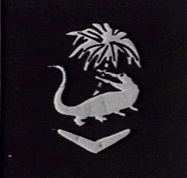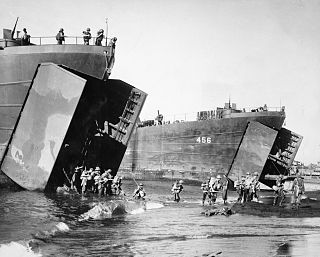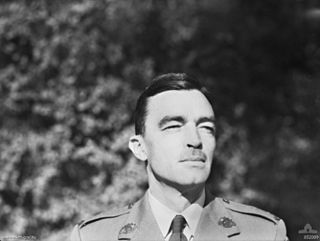
The 4th Armoured Brigade was an armoured formation of the Australian Army established during the Second World War. It was formed in February 1943 to provide armoured support for infantry units operating in the South West Pacific Area. Its composition varied over time, but usually comprised several armoured regiments equipped with Matilda II or M3 Grant tanks as well as some support units.

The Battle of North Borneo took place during the Second World War between Allied and Japanese forces. Part of the wider Borneo campaign of the Pacific War, it was fought between 10 June and 15 August 1945 in North Borneo. The battle involved a series of amphibious landings by Australian forces on various points on the mainland around Brunei Bay and upon islands situated around the bay. Japanese opposition to the landings was sporadic initially, although as the campaign progressed a number of considerable clashes occurred and both sides suffered relatively significant casualties. Ultimately, however, the Australians were successful in seizing control of the region, although to a large extent the strategic gains that possession of North Borneo provided the Allies with were ultimately negated by the sudden conclusion of the war in August 1945.

The 2/2nd Battalion was an infantry battalion of the Australian Army raised for service as part of the all-volunteer Second Australian Imperial Force during World War II. Raised in October 1939, the battalion was deployed to the Middle East and in early 1941 took part in the first ground action undertaken by Australian troops during the war during the Battle of Bardia before helping to capture Tobruk. In April, the battalion briefly fought in Greece, before being evacuated after the Allied forces were overwhelmed by German forces. Some members of the battalion took part in the Battle of Crete, after which the battalion undertook garrison duties in Syria. In mid-1942, the 2/2nd undertook defensive duties in Ceylon before returning to Australia. They subsequently took part in the fighting against the Japanese along the Kokoda Track and then around Buna–Gona. After a period of reorganisation and training in Australia throughout 1943–44, late in the war the battalion was committed to the Aitape–Wewak campaign before being disbanded in early 1946 after the war.

No. 15 Squadron was a Royal Australian Air Force (RAAF) light bomber and maritime patrol squadron of World War II. The squadron was formed in January 1944 and initially flew anti-submarine patrols off the east coast of Australia. From September that year elements of the squadron took part in the New Guinea Campaign, and the main body of the squadron moved to New Guinea in March 1945. Its duties in New Guinea included anti-submarine and anti-barge patrols as well as attacking Japanese positions. No. 15 Squadron was demobilised after the end of the war, and was formally disbanded in March 1946.

The Markham and Ramu Valley – Finisterre Range campaign, was a series of actions in the New Guinea campaign of World War II. The campaign began with an Allied offensive in the Ramu Valley, from 19 September 1943, and concluded when Allied troops entered Madang on 24 April 1944. During the campaign, Australian forces – supported by Australian and US aircraft – advanced through the Markham and Ramu Valleys during which there were minor clashes with Japanese forces, which withdrew towards their main defensive line in the Finisterre Range. The central geographical and strategic feature of the campaign was the imposing Shaggy Ridge, running north-south in the Finisterres; this was the scene of a climactic battle during which the Australians assaulted the Japanese positions in December 1943 and January 1944. Following the fighting around Shaggy Ridge, the Japanese withdrew towards the northern coast of New Guinea, where they were pursued by Australian and US forces advancing through the Finisterres and along the coast from Saidor. Following the capture of Madang, the Japanese eventually withdrew to Wewak where further fighting took place in 1944 and 1945.

The Huon Peninsula campaign was a series of battles fought in north-eastern Papua New Guinea in 1943–1944 during the Second World War. The campaign formed the initial part of an offensive that the Allies launched in the Pacific in late 1943 and resulted in the Japanese being pushed north from Lae to Sio on the northern coast of New Guinea over the course of a four-month period. For the Australians, a significant advantage was gained through the technological edge that Allied industry had achieved over the Japanese by this phase of the war, while the Japanese were hampered by a lack of supplies and reinforcements due to Allied interdiction efforts at sea and in the air.

The Landing at Aitape was a battle of the Western New Guinea campaign of World War II. American and Allied forces undertook an amphibious landing on 22 April 1944 at Aitape on northern coast of Papua New Guinea. The amphibious landing was undertaken simultaneously with the amphibious landings of Battle of Hollandia at Hollandia to isolate the Japanese 18th Army at Wewak.

The Battle of Labuan was an engagement fought between Allied and Imperial Japanese forces on the island of Labuan off Borneo during June 1945. It formed part of the Australian invasion of North Borneo, and was initiated by the Allied forces as part of a plan to capture the Brunei Bay area and develop it into a base to support future offensives.

The Aitape–Wewak campaign was one of the final campaigns of the Pacific Theatre of World War II. Between November 1944 and the end of the war in August 1945, the Australian 6th Division, with air and naval support, fought the Imperial Japanese 18th Army in northern New Guinea. Considered a "mopping up" operation by the Australians, and although ultimately successful for them with the Japanese forces cleared from the coastal areas and driven inland, amidst difficult jungle conditions, casualties from combat and disease were high. With Japan on the verge of defeat, such casualties later led to the strategic necessity of the campaign being called into question.

The Landing at Lae was an amphibious landing to the east of Lae and then the subsequent advance on the town during the Salamaua–Lae campaign of World War II. Part of Operation Postern, which was undertaken to capture the Japanese base at Lae, the landing was undertaken between 4 and 6 September 1943 by Australian troops from the 9th Division, supported by US naval forces from the VII Amphibious Force. The first major amphibious operation undertaken by the Australian Army since the failed Gallipoli Campaign, the Australians invested a significant amount of effort into planning the operation.
The 2/7th Commando Company was one of 12 independent companies or commando squadrons raised by the Australian Army during the Second World War. Raised in May 1942, as the 2/7th Independent Company, the 2/7th served in New Guinea in 1943 during the Salamaua–Lae campaign before being redesignated as the 2/7th Commando Squadron when it was amalgamated with two other commando squadrons to become part of the 2/6th Cavalry (Commando) Regiment. Later at the end of 1944, it was sent to New Guinea again, where it took part in the Aitape–Wewak campaign. Following the end of the war, the squadron was returned to Australia and disbanded early in 1946.
The 2/8th Commando Squadron was one of 12 independent companies or commando squadrons raised by the Australian Army during the Second World War. Raised in July 1942 as the 2/8th Independent Company, the 2/8th spent the early years of the war performing garrison duties in the Northern Territory. In July 1944, the 2/8th sailed to Lae, in New Guinea from where they launched a clandestine reconnaissance operation on the island of New Britain. Later, attached to the II Corps, it participated in the Bougainville campaign, during which it was in action continuously for a period of nine months right up until the Japanese surrendered in August 1945. Following the end of hostilities, the 2/8th returned to Australia, and was disbanded at Liverpool, New South Wales in early January 1946.

The 2/11th Commando Squadron was a commando unit raised by the Australian Army for service in World War II. Raised in 1944, the unit saw action late in the war against the Japanese during the Borneo campaign in 1945. As a part of this campaign the squadron undertook landings on Labuan Island and at Brunei Bay. Following the end of the war, the squadron returned to Australia and was disbanded in early 1946.

No. 71 Wing was a Royal Australian Air Force (RAAF) wing of World War II. It was formed in February 1943 at Milne Bay, Papua New Guinea, as part of No. 9 Operational Group. The wing initially comprised two squadrons of P-40 Kittyhawks, one of Lockheed Hudsons, and one of Bristol Beauforts. The wing's mainstay soon became the Beaufort, which eventually equipped five squadrons attached to the formation. No. 71 Wing took part in the New Guinea campaign under the auspices of No. 9 Group, before transferring to No. 10 Operational Group for the Western New Guinea campaign during 1944. It then returned to the control of Northern Command to support Australian ground forces in the Aitape–Wewak campaign, and completed its final combat mission only hours before the Japanese surrender in August 1945. No. 71 Wing remained in New Guinea following the war and was disbanded in January 1946.

The Battle of Porton Plantation took place near the village of Soraken on Bougainville Island, in the Solomon Islands archipelago during World War II. Involving forces from Australia, New Zealand and Japan, the battle was part of the wider Bougainville campaign, which had begun in late 1943 and lasted until the end of the war in August 1945. The battle formed part of Australian efforts to liberate the northern part of Bougainville.

The Landing at Jacquinot Bay was an Allied amphibious operation undertaken on 4 November 1944 during the New Britain Campaign of World War II. The landing was conducted as part of a change in responsibility for Allied operations on New Britain. The Australian 5th Division, under Major General Alan Ramsay, took over from the US 40th Infantry Division, which was needed for operations in the Philippines. The purpose of the operation was to establish a logistics base at Jacquinot Bay on the south coast of New Britain to support the 5th Division's planned operations near the major Japanese garrison at Rabaul.

Northern Command was one of several geographically based commands raised by the Royal Australian Air Force (RAAF) during World War II. Established in April 1944, it evolved from No. 9 Operational Group, which had been the RAAF's primary mobile formation in the South West Pacific theatre since September 1942, but had lately become a garrison force in New Guinea. Northern Command was headquartered initially at Milne Bay and then, from August 1944, in Madang. It conducted operations in New Guinea, New Britain, and Bougainville until the end of the war. Re-designated Northern Area in December 1945, it was headquartered in Port Moresby from March 1946 and disbanded in February 1947.


























